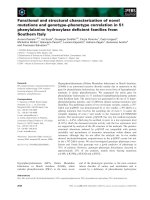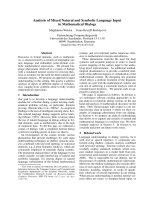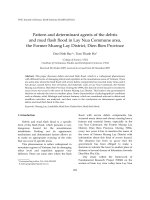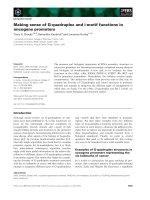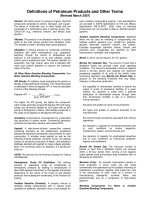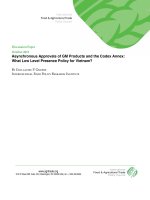sales force competency of steels products and energy business division in mitsui &co viet nam ltd
Bạn đang xem bản rút gọn của tài liệu. Xem và tải ngay bản đầy đủ của tài liệu tại đây (519.84 KB, 86 trang )
National economics university
Neu business school
Le ha minh
Sales force competency
of Steels Products and Energy Business Division
in Mitsui &Co Viet Nam Ltd
Hanoi – 2013
National economics university
Neu business school
Le ha minh
Sales force competency
of Steels Products and Energy Business Division
in Mitsui &Co Viet Nam Ltd
SUPERVISOR: PHD. NGUYEN QUOC DUY
Hanoi - 2013
ACKNOWLEDGEMENT
In order to complete thesis “Sales force competency of Steels Products and
Energy Business Division at Mitsui &Co Viet Nam Ltd”, I got supports from
professors at Business school – National Economic University, especially Dr.
Nguyen Quoc Duy – my supervisor. During the time for completing my research,
he helped me by his best when necessary. He gave me useful guidance and full
information so that I can report my thesis on time. He is really a professional
supervisor with valuable supports.
Moreover, I also want thank to all employees Mitsui &Co Viet Nam Ltd,
including: Board of Directors, all managers and staffs that helped me so much
during time of studying my research. I would like to express my thanks to Dr. Sato
Motonobu, General Director of Mitsui & Co. Vietnam Ltd. and Mr Nagasawa
Masayuki, General Manager of Steels Products and Energy Business Division
because of their advice for me during my MBA course and research. In addition, I
wish to say thanks to Mr. Asaga Minoru, General Manager of Human Resource
Division, Ms. Chu Nguyen Thanh Thuy, Manager of Human Resource Division and
their staffs to provide me lots of useful information about human strategy, salary
policy, human management form, etc.
In conclusion, I would like to say thanks to all managers, staffs of EMBA
program who helped all EMBA students in studying and research during 2 years.
Thank you very much!
i
TABLE OF CONTENT
ACKNOWLEDGEMENT i
TABLE OF CONTENT ii
ABBREVIATIONS iv
LIST OF Diagram & TABLES v
EXECUTIVE SUMMARY vii
CHAPTER 1: INTRODUCTION 1
1.1. Rationale 1
1.2. Research Objectives 3
1.3. Research Question 3
1.4. Research Methodology 4
1.4.1. Research process: 4
1.4.2. Collecting data: 4
1.4.3. Data Analysis 5
1.5. Scope of research 6
1.6. Research structure: 6
CHAPTER 2: THEORETICAL FRAMEWORK ON COMPETENCY 7
2.1. Nature of competency 7
2.2. Competence model 9
2.3. Components of competence 11
2.3.1. Components of selling competence: 11
2.3.2. Competency assessment method and process 14
2.3.3 Factors affect to competency at an organization 18
CHAPTER 3: SALE STAFFS COMPETENCY IN STEELS PRODUCTS
AND ENERGY BUSINESS DIVISION AT MITSUI CO VIET NAM Ltd 19
3.1. Requirement of sales force for sale staff competency in SPEBD at Mitsui
Vietnam 19
3.1.1 .Overview of Mitsui Vietnam 19
ii
3.1.2. Sales force job analyze of SPEBD at Mitsui Viet Nam 24
3.1.3. The requirement for competency of sales forces at SPEBD 30
3.2. Current competencies of sales force at SPEBD analysis 38
3.2.1. Current knowledge 39
3.2.2. Current skills 43
3.2.3. Current attitude 50
3.2.4. Overall assessment on the gap of competency 52
3.3. The strengths and shortcoming of sales force’ competencies 53
CHAPTER 4: SOLUTION AND RECOMMENDATIONS 56
4.1. Orientation of Mitsui business in the near future 56
4.2. Solution to improve sales staffs’ competencies of SPEBD 57
4.2.1. Improving Training and Development 57
4.2.2 Improving Non-Training and Development 60
4.2.3. Recommendation to improve sales staffs’ competencies of SPEBD 63
CONCLUSION 68
REFERENCES 70
APPENDIX 1 GUIDELINE FOR IN-DEPTH INTERVIEW GENERAL
INPORMATION 71
APPENDIX 2 QUESTIONNAIRES CURRENT COMPETENCIES OF SALE
STAFFS AT SPEBD OF MITSUI COMPANY 72
iii
ABBREVIATIONS
MITSUI VIET NAM MITSUI & Co. VIETNAM Ltd
SPEBD Steels Products and Energy Business Division
VSA Vietnam Steels Association
WTO World Trade Organization
iv
LIST OF DIAGRAM & TABLES
Diagram:
Diagram 2.1: Components of selling competencies 11
Table
Table 3.1: Structure of the SPEBD 25
Table 3.2: Sales Process of the SPEBD 26
Table 3.3: Results of Mitsui Vietnam Business and Business Division sales of steel
in the years 2008 – 2012 27
Table 3.4: Members of SPEBD 28
Table 3.5: Basic salary of the Sales Department’s sales force: 29
Table 3.6: Responder of the deep-interview 30
Table 3.7: Requirement for competencies of the sale staff at SPEBD 30
Table 3.8: Respondent rate 39
Table 3.9: Knowledge on market and industry 40
Table 3.10: Knowledge on company and functions Of the Steels Products and
Energy Business Division 41
Table 3.11: Knowledge on Product of the Steels Products and Energy Business
Division 42
Table 3.12: Evaluation problem solving 43
Table 3.13: Evaluation assessment skill 43
Table 3.14: Evaluation forecast skill 44
Table 3.15: Evaluation Planning 44
Table 3.16: Evaluation communication 45
Table 3.17: Evaluation negotiation 46
Table 3.18: Evaluation teamwork 47
Table 3.19: Evaluation presenting 47
Table 3.21: Evaluation foreign language 49
v
Table 3.22: Evaluation taking responsibility 50
Table 3.23: Evaluation Enthusiasm and quality sellers 50
Table 4.1: The contents of the training courses 58
Table 4.2: Commissions for employees monthly sales 61
Table 4.3: Redistricting bonus for employees 62
Table 4.4: Weekly reports of sales representatives 65
vi
EXECUTIVE SUMMARY
From the 2000s, Vietnam’s construction industry has been developing rapidly.
During sustainable development period, the urban environment is also taken care. It
is the reason for the booming of Vietnam construction industry.
On the background of the market economy, especially after Vietnam’s entry
into the World Trade Organization (WTO), the most important objective of the
domestic economy is to enable local enterprises to sustain and develop in such a
fiercely competitive market. Enterprises must apply new technology and develops
human resource strategy in order to survive in the competitive environment of both
domestic and international market. Among important strategies to keep local
enterprises alive, policy of the human resource considered as the first and foremost
factor to develop.
This thesis is written based on the fact of Mitsui Viet Nam is facing with the
problem of losing competitive advantage in term of human resource’s quality for its
future development to become a leading steel company in Vietnam. This weakness
induces Mitsui Viet Nam easily to lose potential business opportunities due to the
lack of competent people who do the job in the most effective way. Therefore, the
company is trying to overcome this bad situation by improving human resource
specially managers that the company did not pay much attention before.
In the scope of my thesis, the study was conducted to identify required
competencies Mitsui Viet Nam’s sale office and assess their current competencies
to determine the gap between requirements and their current competencies, thereby
giving some implications for addressing that gap.
Based on literature foundation of the competency, competency model, job
analysis, synthesis and qualitative analysis of primary and secondary data are used
to test. Primary data are collected by in depth interviews and questionnaire survey.
Secondary data were collected mostly from the company policies, regulations,
reports. From analyzing job performance and interview results, requirement of
vii
competencies required were identified for the sale staff including: (1) Knowledge;
(2) Skills: Personal Skill; Interpersonal Skill; Work Skill; (3) Attitude
Basing on given competencies criteria, the survey was conducted to assess the
current competencies of the sale staff at Mitsui Viet Nam in Hanoi. In this step,
360o evaluation method was used to identify their current competencies.
The questionnaire survey was designed and revealed some key findings as follow:
The Score that people give for most of competency criteria were not high such
as. It means that the sale staff has some competencies not meet requirements of the
company and they should improve these competencies immediately.
The sale staff’s evaluation on competencies of themselves is higher than
managers and customers. It proved that they are over confident in their
competencies.
The gap between current and required managerial competencies for project
officer of the company was identified. This is a big gap problem that the company is
facing and they should consider to taken the right actions for addressing this gap
and improving these competencies of the sale staff immediately.
Basing on these findings, the thesis suggested some solutions for addressing
the gap between the current competencies of sale staff and the company’s
requirements. I would like to suggest REST progress, which improves the
competencies of sale staffs, included four function need to be implemented
carefully, and they are: Recruiting and selection, Evaluation, Succession planning,
Training and Development
The thesis focused only on two solutions including training solution and non-
training and development solution. In training solution, the thesis suggested internal
training and external training plan. In non-training and development solutions, the
thesis focused on policy of Compensation, Developing Incentive and Bonus term
and Conditions, policy of Punishment, Improving Evaluation to explore ways that
can help the company achieve effectiveness of the solutions in improving of sale
staff as well as human resource’s
viii
CHAPTER 1: INTRODUCTION
1.1. Rationale
Nowadays, the economic integration with the regional and global economy
has recently accelerated in Viet Nam, hence competition is fierce. One of the
measures for development of companies is improving its sales force because sales
force can build long-term exchange relationships that bring benefit to their
customers and the company it represents. Sales force competency requires sales
managers to attract and retain salespeople who can create a more value-added
relationship with customers and play an important role in producing corporate’s
revenue, especially in the context that products’ features and benefits are often
readily available online. Therefore competency for salesman in the company is an
important issue.
Mitsui & Co Viet Nam Ltd was established in 2006. The main business of
Steels Products and Energy Business Division is that Import/ Export & domestic
trading business on Iron & Steel material for various area, construction steel,
automotive steel, plate for ship – building, home electronics, stainless and special
steel for domestic market. The Steels Products and Energy Business Division is
working to improve the sales and distribution of steel products to market to
customers and to system of businesses. The turnover from Steels Products and
Energy Business Division has accounted for about 80-85% total turnover of the
Company. This result is due to the following factors:
The objective cause: According to the statistics of Vietnam Steels
Association (VSA), the number of steels producers totals about 400 and there are
nearly 600 steels trading companies in the industry whereas the real estate market is
still in the slowdown period with plummeting demand.
The inequality between supply and demand has lead to fierce competition in
the industry and make the market share of Mitsui to be downsized from 10% (2009)
to 6% (2012)
1
The subjective cause: the company’s sales force has yet to live up to the
management expectations in terms of the size and competence.
The above-mentioned factors have led the company’s turnovers to be in the
decreasing trend over the period:
Billion VND
Indicators 2008 2009 2010 2011 2012
Total Sales 651 732 528 498 423
Total Cost 521 600 499 522 455
Net profit after tax 130 132 29 -24 -32
Steel Department Sales 480 598 341 299 253
Facing the above difficulties, the Energy and Steel Product Business Division
has been assigned by the Mitsui Viet Nam Board of Managers to achieve a growth rate
of 10-20% annually in the upcoming years. Therefore, we can see that the role of the
Energy and Steel Product Business Division is very important. They take in charge of
controlling sales network as well as Carrying out researches, evaluate the
effectiveness of sales policies and current service standards to promote sales,
improve service quality. So the sales force plays a key role in Steels Products and
Energy Business Division. Consequently, sales force competences are required as
perfect as possible.
From these rationales, this research topic focus on the issue “Sales force
competency of Steels Products and Energy Business Division at Mitsui & Co
Viet Nam Ltd", thus generating the limitations of active sales force to provide a
basis for finding solutions to improve sales force competences at Mitsui & Co Viet
Nam Ltd.
2
1.2. Research Objectives
The goal of the research is to close the gap between evaluated and required
competencies Steels Products and Energy Business Division at Mitsui & Co Viet
Nam Ltd. So I focus on four contents:
Clarify the competency requirements of sales force at Steels Products and
Energy Business Division
Analyze the current sales forces competencies and find out the gap between
required and current competencies of sales force under theoretical
background applied.
Propose the solutions to close the gap between evaluated and required
competencies Steels Products and Energy Business Division at Mitsui & Co
Viet Nam Ltd.
1.3. Research Question
In order to complete the objectives of research, the author designed three
research questions as:
To match and gain the above objectives, the writer sets out some questions that
need to find the answers to solve the problem:
Which are the requirements of competencies for sale staffs at Steels Products
and Energy Business Division ?
What are the current competencies of sales force and the gap between current
sales force’s competencies and requirement need at Steels Products and
Energy Business Division ?
What are solutions to improving sales force competencies?
3
1.4. Research Methodology
1.4.1. Research process:
The research process will be described as follows:
1.4.2. Collecting data:
1.4.2.1. Secondary data:
- From the previous studies which the writer searched. There are some
researches on competence. They focus on definitions and the information in the
previous studies will be a useful and necessary data source for our research.
- From Mitsui & Co Viet Nam Ltd of documents, reports, policies,
regulations, labor agreement: show the performance of sales staff
- Other articles on newspapers, journals, books, magazines related to
competency subject.
1.4.2.2. Primary data:
Colleting primary data is very important for the author implement this research.
Based on desire of this thesis, resolving power and authentic of data, the author chose 2
formally information gathering: in-depth interview and questionnaire survey.
Sale staff’s job analysis
Required
competence
for sale staffs
Theoretical Background on
competence
Interview with Leaders
Surveys:- Managers
- Sale Staffs
- Customer
Current
competence of
sale staffs
Gap Recommendation
4
a) Method of in-depth interview with the following key persons of SPEBD:
- 01 Director of Mitsui Vietnam.
- 01 Manager of Steels Products and Energy Business Division .
Approach ways of in-depth interview are:
- Meeting directly key managers in Mitsui Vietnam
- Proposing questions based on list of prepared questions
- Collecting opinions and comments.
The purposes of the in-depth interviews are:
- To identify the current salesmen competency of SPEBD.
- To find out the evaluation of sale staff competency
- To find out the requirement for competencies of the sale staff at SPEBD
b) Survey: This research used survey method to give questionnaire to 13
current sales staff of Division to collect data about their opinions about
themselves as well as their colleagues’ competencies, and 50 customers to
collect data about current salesmen competencies and their demand.
1.4.3. Data Analysis
From the primary data that were collected, it have been used to figure out
what that data to serve for the research. The keys when analyzing the data is to pull
out information that is the most pertinent to the research.
When analyzing survey, the raw data has been got into that can be
manipulated. The results of multiple choices answer system in the survey have been
entered into Excel spreadsheet to answer the research question.
Secondary data can be a valuable source of information for gaining knowledge
and insight into a broad range pf issues and phenomena. Review and analysis of
secondary data can Review and analysis of secondary data can provide a cost-effective
way of adressing issues, conducting cross-national comparisons, understanding country
-specific and local conditions, describing the current situation.
5
1.5. Scope of research
Object: The thesis focus on competency of sales force Steels Products and
Energy Business Division at Mitsui & Co Viet Nam Ltd through improving sale
staffs competency of Steels Products and Energy Business Division at Mitsui & Co
Viet Nam Ltd.
Time:
Secondary data: 2 consecutive years 2011 – 2012
Primary data: will be collected via questionnaires and face to face interview
from April to July, 2013
Research Schedule
1.6. Research structure:
CHAPITER 1: INTRODUCTION
CHAPITER 2: THEORETICAL FRAMEWORK ON COMPETENCY.
CHAPITER 3: SALE STAFFS COMPETENCY IN STEELS PRODUCTS
AND ENERGY BUSINESS DIVISION AT MITSUI & Co. VIETNAM Ltd.
CHAPITER 4: SOLUTIONS AND RECOMMENDATIONS
6
CHAPTER 2: THEORETICAL FRAMEWORK
ON COMPETENCY
2.1. Nature of competency
Competence has been long understood as a person’s ability or capacity to do
a job. It was devised in the 1970s by the US Company McBer to identify the
specific personal characteristics which resulted in effective and/or superior
performance.
So, what exactly is the idea behind competencies ?
Every job has a requirement of specific set of competencies to undertake it
efficiently, and the individuals who would perform the job need to be laced with
those competencies. One of the interesting and worth mentioning aspect of this term
is that it focuses not on what a person can do but on what a person can learn. This
forward looking approach makes it quite popular amongst training providers and
recruitment experts.
Competencies with their specific behavioral indicators facilitate the
demonstration of appropriate skills and behaviors, it is not a set of tasks performed
like a robot neither it is an underlying capacity which is never demonstrated.
Competency also includes motivation and self-knowledge, a desire and
willingness to demonstrate effective performance.
So, with this information we can proceed to defining Competency:
A set of individual performance behaviors which are observable, measurable
and critical to successful individual and company performance.
Individual characteristics of a person which result in an effective and
superior performance in a job.
There has been a lot of debate on the aspect that whether competencies are
unique to a particular job or they are generic in nature. A little example would help
the understanding, does ‘Management’ require the same set of behaviors to be
7
demonstrated across the organization, job function, location etc by the managers or
they differ across organizations, cultures, functions and settings
Another way, Competency: The combination of observable and measurable
knowledge, skills, abilities and personal attributes that contribute to enhanced
employee performance and ultimately result in organizational success. To
understand competencies, it is important to define the various components of
competencies.
In the scope of the thesis, competency is defined as follow:
Competency = Knowledge + Skills + Attitude
Knowledge is the cognizance of facts, truths and principles gained from
formal training and/or experience. Application and sharing of one's knowledge base
is critical to individual and organizational success.
Skill is a developed proficiency or dexterity in mental operations or physical
processes that is often acquired through specialized training; the execution of these
skills results in successful performance.
Skills include many different fields. You will have to apply a lot of skills to
achieve high efficiency in work. Each occupation, job title, different areas require
different skills. It depends on the ability applications of individual to specific:
- Functional skills (work skills)- are those basic skills used for solcing
normal problems in daily situations. Examples of function skills are
communicating, listening, questioning, analyzing, decision-making and
organizing.
- Adaptive skills (Personal skills and Interpersonal skills)- are those skills
related to personality traits that help the worker adapt to new or changing
environments. Example of adaptive skills are flexibility, positive work
attitude and assertiveness
With managers, skills is also the practice of understanding, developing and
deploying people and their skills. Well-implemented skills management should
8
identify the skills that job roles required, the skills of individual employees, and any
gap between the required skills and individual's skills.
Attitude: are generally positive or negative views of a person (individual's
degree of like or dislike for something), place, thing, or event- this is often referred
to as the attitude object. People can also be conflicted or ambivalent toward an
object, meaning that they simultaneously possess both positive and negative
attitudes toward somebody or something.
Professional attitude is understood as the way of thinking and behaving at
work. Attitudes can affect one's working willingness, tendency of achieving
knowledge at work and affect the result of job performance.
Attitudes have three important characteristics: they are learned, they
predispose action, they have evaluation (favorable-unfavorable, positive-negative,
good-bad). To do an effective job in the change rapid world, the employee needs to
development knowledge, skills and attitude at work. To meet the needs of society
and work, every organization ought to have HRM development plan. To do that,
they must regularly assess the competency of their staff to understand the
weaknesses of HRM in organization.
(Source: />2.2. Competence model
A competency model is a framework for organizing a collection of
observable skills, behaviors, and attitudes that impact the quality of work that
people do. It describes what people need to know and be able to do in order to
execute on their responsibilities effectively.
Even though the definition is pretty simple, the role of competency models in
organizational design has become extremely significant. In fact, as the war for talent
continues to rage, many organizations have come to view competencies as
foundational to effective talent management and have classified competency models
9
as a strategic imperative. The reason for this is that the best organizations are using
competencies to:
+ recruit and select of employees to ensure organizational fit,
+ set performance expectations and measure contributions objectively,
+ focus employees on what is critical to enhancing their contribution and
increasing their satisfaction, and
+ provide a roadmap for employee development and career planning.
In addition, by assessing “competency gaps” in relation to individuals
and groups, competency models become valuable inputs to creating highly
targeted training initiatives.
Developing Competency Models: Competency enable employees to
achieve results, there by creating value. It follows that competencies aligned
with business objectives help foster an organization's success. Organizations
must understand their core competency needs- the skills, knowledge,
behaviors, and abilities that are necessary for people in key roles to deliver
business results.
According to Boulter, at al (1998), there six stages involved in defining a
competency model for a given job role. These stages are:
1. Performance criteria- Defining the criteria for superior performance in the
role.
2. Criterion sample- Choosing a sample of people performing the role for
data collection.
3. Data collection- collecting sample data about behaviors that lead to
success.
4. Data analysis- Developing hypotheses about the competencies of
outstanding performers and how these competencies work together to
produce desired results.
5. Validation- Validating the results of data collection and analysis.
10
6. Application- Applying the competency models in human resource
activities, as needed.
2.3. Components of competence
2.3.1. Components of selling competence:
An effective competence management system management system will
monitor each of the key components of competence, as shown below:
Diagram 2.1: Components of selling competencies
(Source: http:// www. trainism.com/be-supremely-self-competent-be supremely-self-
competent- article. html)
In selling, the sale competencies are behaviors that encompass the selling
knowledge, selling skills, and selling attitudes required for successful performance.
Selling skills:
There are five (5) Critical Sell skills that make the greatest impact on
moving the sale forward. If your sales teams master these skills within a sale
process that matches how customers make decisions, you will see dramatic and
consistent in sales productivity
1. Managing the Buyer/Seller Relationship
2. Sales Call Planning
3. Sales Questioning Skills
4. Sales Presentation Skills
11
5. Gaining Commitment
There are three reasons why these selling skills are the highest pripority
1. Sales staffs can be taught how and when to use each skill. (Success is not
based on personality.)
2. Skill level and learning can be measured. Our assessment will measure skill
level and give on – the – spot recommendations on how to improve in each key area.
3. When these skills are mastered, your business will see a dramatic increase
in sales productivity.
Selling knowledge:
Selling knowledge is power and for retailers, product knowledge can mean
more sales. It is difficult to effectively sell to a consumer if we cannot show how a
particular product will address a shopper
’
s needs. Read on to learn some of the
benefits of knowing the products you sell.
Strengthens Communication Skills
Having a thorough understanding of the products on the shelves can allow a
retailer to use different techniques and methods of presenting the product to
customers. Stronger communication skills will allow a salesperson to recognize and
adapt a sales presentation for the various types of customers.
Boosts Enthusiasm
Seeing someone completely enthusiastic about a product is one of the best
selling tools. As you generate excitement for the product, you remove any
uncertainty the product may not be the best solution for that customer. The easiest
way to become enthusiastic is to truly believe in the product.
Grows Confidence
If a customer isn't fully committed to completing a sale, the difference may
simply be the presence (or lack) of confidence a salesperson has towards
theproduct. Becoming educated in the product and its uses will help cement than
confidence.
12
Assists in Overcoming Objections
Objection made by customers may be struck down with factual information
regarding the product. That information usually comes in the form of product
knowledge. Being well versed in not only your products, but similar products sold
by competitors, allows you to easily counter objections.
How to Gain Product Knowledge
• Marketing Literature
• Sales Reps
• Training Sessions
• Testimonials
• Role Playing
• Practical Use
It is important to understand how the product is made, the value of the
product, how the product should and can be used, and what products work well
together.
What to Know About Your Products
• Pricing structure
• Styles, colors or models available
• History of the product
• Any special manufacturing process
• How to use the product
• Product distribution and delivery
• Servicing, warranty and repair information
It may take a while to easily articulate your product knowledge, especially
with new products, but over time you will become comfortable and confident in
providing the correct information to shoppers. That confidence will pay off in
13
improved sales results.
In Sales, Your Attitude is Important:
Your attitude is what drives all your physical learning and behaviors, if your
attitude is off in the slightest you can be sure that this will be reflected in your
results. Often times when results do not appear to be going your way the answer can
be found in your attitude somewhere. (Article Source:
http:/lEzineArticles.com/2117505).
2.3.2. Competency assessment method and process
Competency assessment method according to 360 Degree Feedback :
There are four methods to evaluate the competencies of salesmen such as self
assessment by employee, supervisor's evaluation, customer's assessment and the last
one is 360 degree feedback
The first one is self assessment by employee. Salesmen will evaluate
themselves base on the common competencies criteria. The advantage of this
method is nobody can understand you by yourself. And the disadvantage of this
method is their evaluation is not exact in some case.
The second one is manager's or supervisor's evaluation. This assessment
usually is made at the end of month, quarter, years The advantages of this method
are save time and exact evaluation, because the manager can understand their staffs
through daily working. The disadvantages of this method are: emotional factor
influence, different level manager will have different way to evaluate salesmen.
The third one is customer's assessment. Salesmen have to perform and
contact with their customer everyday to make a deal, to present their selling
knowledge for any customer's questions… Therefore, customer will evaluate the
qualification of salesmen through their feeling. The advantages of this method are
showing the requirement of customer about the services of company and
requirement of customer about the behavior or experience of salesman. The
disadvantages of this method are: need long time to collect assessments' from
14
customer, some trouble happen with' unready customer and the quality of the
evaluation is influenced by customer's emotion.
360 Degree Feedback is a system or process in which employees receive
confidential, anonymous feedback from the people who work around them. This
typically includes the employee's manager, peers, and direct reports. A mixture of
about eight to twelve people fill out an anonymous online feedback form that asks
questions covering a broad range of workplace competencies. The feedback forms
include questions that are measured on a rating scale and also ask raters to provide
written comments. The person receiving feedback also fills out a self-rating survey
that includes the same survey questions that others receive in their forms.
Managers and leaders within organizations use 360 feedback surveys to get a
better understanding of their strengths and weaknesses. The 360 feedback system
automatically tabulates the results and presents those in a format that helps the
feedback recipient create a development plan. Individual responses are always
combined with responses from other people in the same rater category (e.g. peer,
direct report) in order to preserve anonymity and to give the employee a clear
picture of his/her greatest overall strengths and weaknesses.
360 Degree Feedback can also be a useful development tool for people who
are not in a management role (customers). Strictly speaking, a "non-manager" 360
assessment is not measuring feedback from 360 degrees since there are no direct
reports, but the same principles still apply. 360 Feedback for non-managers is useful
to help people be more effective in their current roles, and also to help them
understand what areas they should focus on if they want to move into a
management role.
360 degree Feedback as a Development Tool to help employees
recognize strengths and weaknesses and become more effective:
When done properly, 360 degree is highly effective as a development tool.
The feedback process gives people an opportunity to provide anonymous feedback
to a coworker that they might otherwise be uncomfortable giving. Feedback
15



